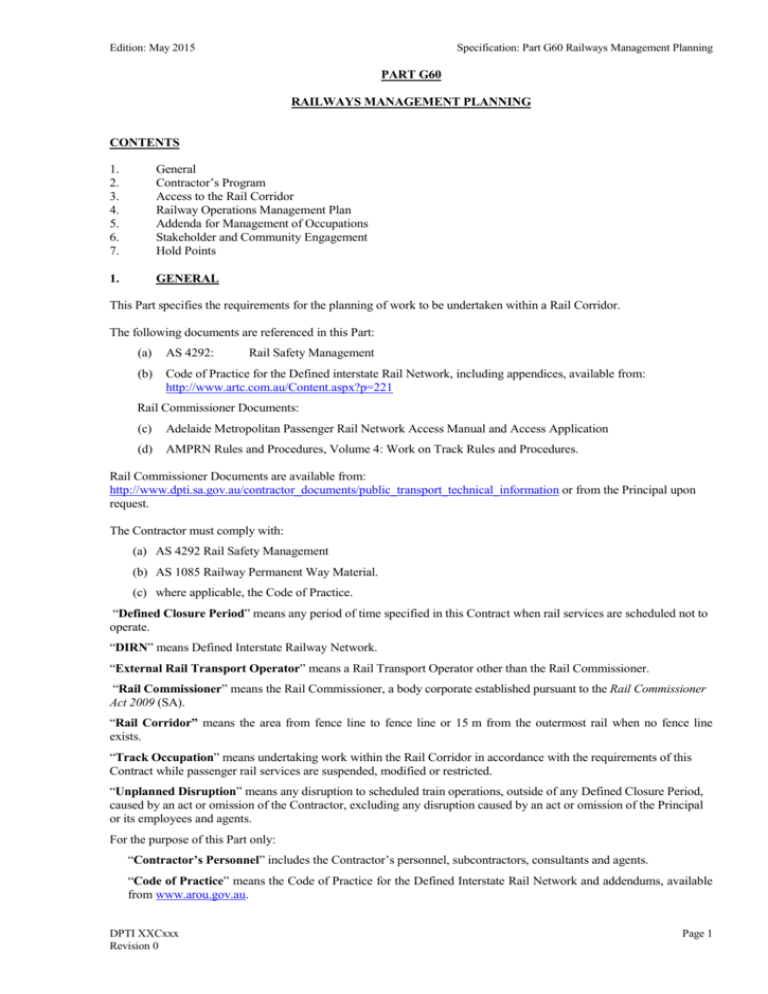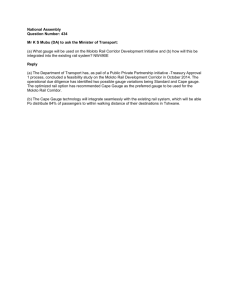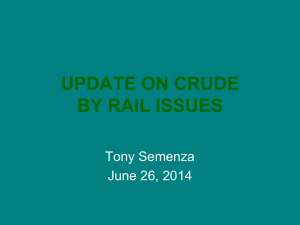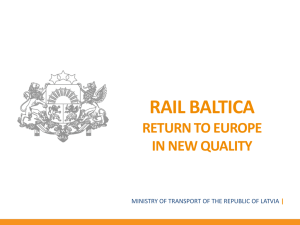Part G60 Railway Managment Systems
advertisement

Edition: May 2015 Specification: Part G60 Railways Management Planning PART G60 RAILWAYS MANAGEMENT PLANNING CONTENTS 1. 2. 3. 4. 5. 6. 7. General Contractor’s Program Access to the Rail Corridor Railway Operations Management Plan Addenda for Management of Occupations Stakeholder and Community Engagement Hold Points 1. GENERAL This Part specifies the requirements for the planning of work to be undertaken within a Rail Corridor. The following documents are referenced in this Part: (a) AS 4292: Rail Safety Management (b) Code of Practice for the Defined interstate Rail Network, including appendices, available from: http://www.artc.com.au/Content.aspx?p=221 Rail Commissioner Documents: (c) Adelaide Metropolitan Passenger Rail Network Access Manual and Access Application (d) AMPRN Rules and Procedures, Volume 4: Work on Track Rules and Procedures. Rail Commissioner Documents are available from: http://www.dpti.sa.gov.au/contractor_documents/public_transport_technical_information or from the Principal upon request. The Contractor must comply with: (a) AS 4292 Rail Safety Management (b) AS 1085 Railway Permanent Way Material. (c) where applicable, the Code of Practice. “Defined Closure Period” means any period of time specified in this Contract when rail services are scheduled not to operate. “DIRN” means Defined Interstate Railway Network. “External Rail Transport Operator” means a Rail Transport Operator other than the Rail Commissioner. “Rail Commissioner” means the Rail Commissioner, a body corporate established pursuant to the Rail Commissioner Act 2009 (SA). “Rail Corridor” means the area from fence line to fence line or 15 m from the outermost rail when no fence line exists. “Track Occupation” means undertaking work within the Rail Corridor in accordance with the requirements of this Contract while passenger rail services are suspended, modified or restricted. “Unplanned Disruption” means any disruption to scheduled train operations, outside of any Defined Closure Period, caused by an act or omission of the Contractor, excluding any disruption caused by an act or omission of the Principal or its employees and agents. For the purpose of this Part only: “Contractor’s Personnel” includes the Contractor’s personnel, subcontractors, consultants and agents. “Code of Practice” means the Code of Practice for the Defined Interstate Rail Network and addendums, available from www.arou.gov.au. DPTI XXCxxx Revision 0 Page 1 Edition: May 2015 Specification: Part G60 Railways Management Planning The definitions in the Rail Safety National Law (South Australia) Act 2012 and the Access Licence have the same meaning in this Part. Except where specified otherwise, the Contractor is responsible for all planning and management associated with access to the Rail Corridor and liaison with the Rail Transport Operator(s). Separate payment will not be made for the costs associated with compliance with the requirements of this Contract. CONTRACTOR’S PROGRAM 2. In addition to the requirements for the Contractor’s Program specified elsewhere in this Contract, the Contractor’s Program must clearly show: (a) all work within the Rail Corridor; (b) the duration of that work; (c) any Defined Closure Periods; and (d) any Track Occupation. 3. ACCESS TO THE RAIL CORRIDOR The Contractor: (a) agrees and acknowledges that it does not have unrestricted access to the Site and it must comply with the restrictions imposed by this Contract and by the Rail Transport Operator; (b) outside of any Defined Closure Period (unless specified otherwise), must permit the Rail Transport Operation to use the Rail Infrastructure and it must not impede the operation of train services; (c) acknowledges that it is fully informed of the scheduled train operations and acknowledges that the Rail Transport Operator may change train schedules at any time outside of any Defined Closure Period; (d) must provide the Rail Transport Operator reasonable access to the Site to undertake inspections, routine maintenance, vegetation removal and/or to rectify any other faults on the Rail Infrastructure; (e) must regularly liaise with the Rail Transport Operator and the Principal to ensure it remains informed of any changes to the train schedules. The Contractor may request a variation to the Defined Closure Period. However, the Principal and the Rail Transport Operator are under no obligation to accept any proposed change and may reject a request at their absolute and unfettered discretion. If the Contractor requires access to the Rail Infrastructure for the movement of the Contractor’s Rolling Stock, that access must be in accordance with the Rail Transport Operator’s operational rules and track access requirements and access windows. 4. LIAISON WITH THE RAIL TRANSPORT OPERATOR The Contractor must: (a) regularly liaise with the Rail Transport Operator so as to remain informed of any changes to the train schedules; (b) provide any information requested by the Rail Transport Operator regarding the nature and programming of the work; (c) where requested by the Principal, attend meetings with the Rail Transport Operator and Principal to discuss the work; and (d) comply with all requirements of the Rail Transport Operator regarding access and rail safety. The contact person(s) for the Rail Transport Operator(s) is listed in Contract Specific Requirements. 5. RAILWAY OPERATIONS MANAGEMENT PLAN DPTI XXCxxx Revision 0 Page 2 Edition: May 2015 Specification: Part G60 Railways Management Planning The Contractor must establish, implement and maintain a Railway Operations Management Plan. The requirements specified in this clause may be included in the Railway Operations Management Plan or in detailed plans, procedures and other documents which are annexed to, or referenced by, the Railway Operations Management Plan. The Plan must include: (a) an overview of all work carried out within the Rail Corridor; (b) how the relevant requirements of AS 4292, the Rail Transport Operator and the Contract will be addressed; (c) roles, responsibilities and accountabilities with respect to management of rail operations; (d) proposed structure of management documentation related to rail operations, which must include details of interfaces between this documentation and other management documentation prepared for the Contract; (e) the management of interfaces between the work under the Contract and the Rail Infrastructure or Rolling Stock Operations, including: i) preparation of documentation, to support the management of interfaces, addressing the requirements of the interface coordination plans as required by AS 4292.1, and interface agreements as required by the Act; ii) details of the scope of works interfacing with the Railway Infrastructure; iii) high level program of works interfacing with Railway Operations (this may refer to, or be part of the Contractor’s Program); iv) summary of the proposed involvement of the Rail Transport Operator in any commissioning and decommissioning procedures; and v) consultation strategy with the Rail Transport Operator. (f) procedures to address the management, and details of proposed arrangements for the following: i) where requested by the Principal, the establishment of a track access and occupations planning group involving the Rail Transport Operator, the Principal, the Contractor and other such parties as necessary to satisfactorily plan and implement the work; ii) site access arrangements and track occupancy, including any planned impacts on rail services and arrangements for management of unplanned disruptions to rail services; iii) maintenance of operational Rail Infrastructure during the Works; iv) track protection; v) staff training and accreditation requirements for planning and implementation of occupation management; vi) any operation of Rolling Stock for construction purposes; vii) where operating in electrified environment, details of operating under the Rail Commissioner’s Safety Management System electrical procedures and the Electrical Network Safety Rules; viii) risk, quality and safety requirements; ix) emergency and security response procedures; and x) notification requirements. (g) details of any measures to prevent damage to Railway Infrastructure, including overhead wires and underground cables; (h) details of any temporary track crossings for vehicles and personnel and measures to prevent unauthorised crossing of tracks; (i) where applicable, calculations necessary to demonstrate that piling, earthworks or temporary works do not affect the stability or alignment of the Railway Infrastructure. (j) method of review and update of the Plan, including arrangements for preparation of Addenda; (k) procedures for audit of the Plan and its implementation; (l) references to the relevant parts of the Contractor’s management plans (e.g. Rail Safety Management Plan, Risk Management Plan and Quality Plan); and DPTI XXCxxx Revision 0 Page 3 Edition: May 2015 Specification: Part G60 Railways Management Planning (m) any other relevant matters. The Contractor must work collaboratively with the Principal and the Rail Transport Operator in the development of the Plan. If not provided beforehand, the Contractor must provide a copy of the Railway Operations Management Plan at least 20 working days prior to the commencement of the work on site under consideration. The Railway Operations Management Plan is a Controlled Document. Provision of the Plan shall constitute a HOLD POINT. 6. ADDENDA FOR MANAGEMENT OF OCCUPATIONS This Clause only applies where the Contractor is undertaking a Track Occupation. The Contactor must establish, implement and maintain Addenda specific to each occupation. The Addenda must address or refer to where relevant site specific issues associated with each and all of the items covered in the Rail Operations Management Plan, such as program, track protection arrangements and resourcing. In addition to the above, the following arrangements must be consistently addressed in each Addendum: (a) occupations must be planned in half hour increments; (b) programs must have nominated go / no go points at which decisions are made to continue with works or to undertake remedial or alternative works to ensure return of services at the agreed time; (c) robust contingency plans must be in place for instances of unplanned service disruption, including procedures to track and monitor progress throughout an occupation and clear chain of command for decision making regarding any contingency planning; and (d) contractors must have a nominated site representative available at all time, who must have the authority to implement contingency measures as appropriate so as to not impact on train operations. An Addendum is a Controlled Document. Addenda must be submitted no later than 6 weeks prior to any proposed occupation. Provision of the Addenda shall constitute a HOLD POINT. 7. STAKEHOLDER AND COMMUNITY ENGAGEMENT Where the Contractor proposes to temporarily close a level crossing, modify a level crossing or requires the temporary suspension of train operations, details of the proposal must be included in the Railway Operations Management Plan. The Contractor must liaise with the Principal and provide all necessary information to enable the Principal to undertake community and stakeholder consultations. The information must be provided at least 28 days prior to the proposal being implemented. If the Contractor becomes aware of events that may lead to an Unplanned Disruption occurring, the Contractor must immediately notify the Principal and the Rail Transport Operator to enable appropriate public notifications and, if necessary, arrange alternative public transport requirements. If the temporary closure of a Level Crossing is required, the Contractor must: (a) provide notification to the Rail Transport Operator in accordance in accordance with the Contract Specific Requirements and / or Access License (where applicable). (b) in liaison with the Principal arrange for public notification of the proposed closures in the relevant newspaper (local and state) both 2 weeks and 1 week prior to closure; (c) notify any residents in a 500 m radius of the proposed closures by letterbox flyer 1 week prior to closure; (d) supply and display advice signs giving details of closure at the crossing site for at least 2 weeks prior to closure; and (e) 8. notify emergency services and transport authorities at least 3 weeks prior to road closure including notifications of proposed detours or deviations. HOLD POINTS The following is a summary of Hold Points referenced in this Part: DPTI XXCxxx Revision 0 Page 4 Edition: May 2015 CLAUSE REF. 5. 6. Specification: Part G60 Railways Management Planning Provision of Railway Operations Management Plan RESPONSE TIME 20 working days Provision of Addenda 6 weeks HOLD POINT ___________ DPTI XXCxxx Revision 0 Page 5 DPTI XXCxxx Revision 0 Page 6








